By Vince Giuliano and Steve Buss
Aging reversal has been the dream of humans for all of our history. It has happened in stories and myths. For example, Hebe was the Greek Goddess of youth. “Hebe had influence over eternal youth[5] and the ability to restore youth to mortals, a power that appears exclusive to her, as in Ovid’s Metamorphoses, some gods lament their favored mortals aging. According to Philostratus the Elder, Hebe was youngest of the gods and responsible for keeping them eternally young, and thus was the most revered by them.[6]. Her role of ensuring the eternal youth of the other gods is appropriate with her role of serving as cupbearer, as the word ambrosia has been linked to a possible Proto-Indo-European translation related to immortality, undying, and lifeforce.[7 She carried a cup with ambrosia. In art, she is typically seen with her father in the guise of an eagle, often offering a cup to him. (ref Wikipedia)”

Hebe, Goddess of youth, feeding Ambrosia, elixir of youth to her father Zeus, shown in art disguised as an eagle. Image source Wikipedia
This an introduction to a series of blog entries dealing with the science of age reversal approaches. Ambrosia existed in mythology in the 5th century BCE. Now in 2020, established science indicates that there are substances in the blood of younger people that can restore the youth of older people. We are now hot on the trail of understanding YOUNGING, the biological processes through which youth can be restored, and developing practical means for doing this. This new knowledge is timely, so you may end up benefitting from it personally. We are telling this story and the science behind it in a new series of blog entries. The first of these is already published. It is YOUNGING 1.0 – THE EMERGING AGING REVERSAL STRATEGY. After reading that basic post you might want to go on to read YGC MORE ON YOUNGING1.0 – THE EMERGING AGING REVERSAL STRATEGY and YGD YOUNGING1.0 PART 4: UNDERLYING MECHANISMS OF YOUNGING 1.0. HSC STEM CELL DIFFERENTIATION.
Over the last century, increasingly sophisticated concepts, scientific tools, and communication technologies have triggered an explosion of knowledge about Aging and how it might be slowed. We have sought to highlight evidence of this knowledge over the last dozen years in this blog.
But this cumulative increase in evidence wasn’t significant enough that we could integrate it into a reasonably complete sketch of the causes of aging with certainty until now. Still, “aging theories” have emerged from the certain meager knowledge we’ve had, and these theories have been much researched and discussed in the absence of more conclusive evidence.
Only very recently has experimental evidence from diverse fields hinted at explanations that, when integrated, provide a clearer view of the causes of Aging and means for slowing or reversing it.
It’s now possible to sketch a Biological-Age-Reversal-Strategy, Version 1.0, that is grounded in the evidence and settled explanations of that evidence, from a diverse set of research studies. Some of these studies are already well-known within the longevity science community. Others are less well-known, even virtually unknown, within the community but still consequential for this strategy.
We call this strategy YOUNGING 1.0 because, like Aging, it is a process rather than a sudden transformation. It’s similar in its progression to normal Aging, but in reverse. We expect our understanding of this process to broaden and deepen over time enough to merit appending a version number to each successive sketch.
In this and the next several blog posts, we will sketch this YOUNGING 1.0 strategy. Some of these posts are likely to be among the most important ever published in the 12-year history of ANTI-AGINGFIREWALLS.
We sketch some central details of this strategy in our post YOUNGING 1.0 – THE EMERGING AGING REVERSAL STRATEGY, which is already published. We address few key related issues in the remainder of this post.
About “YOUNGING“
Our commitment in this blog is to convey knowledge and insight about where the sciences connected with longevity stand. Mostly we seek to report facts and on research of others, where there is relatively little disagreement among knowledgeable scientists. Other times, we write about topics on which there is significant disagreement or silence. In each case, we lay out what we see to be so in our unique manner, linking up disparate pieces of research into a meaningful framework. Other times, we relate personal commentaries on our own experiences. Where gaps in knowledge may exist, we may speculate on what may best fill those gaps. This YOUNGING series embodies elements of all of the above. We think the time has come to lay out the picture now best as we can. While we see our first sketch as compelling, major gaps in our knowledge are still to be filled in. The total picture may not be clear for many years to come.
In scientific experiments, intervention techniques associated with this YOUNGING 1.0 strategy have been shown to provide
- health benefits, survival probability increases, and aging reversal in small animals
- health and survival probability benefits in humans
There are good reasons to believe that the aging reversal they will work in humans as well.
Why now, finally, can we begin to sketch a YOUNGING Strategy with greater certainty?
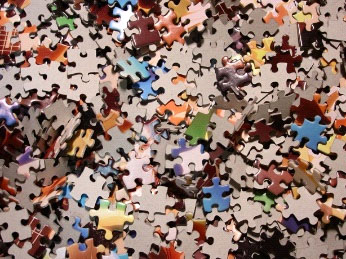
I (Vince) gave a talk several years ago in which I asserted that aging-related science is like a multi-dimensional puzzle with 100,000 pieces: A puzzle having no box cover depicting what its assembled pieces look like. Solving the longevity puzzle is a process with many similar steps that those who have worked on large puzzles are familiar with.
- A good way to start is by sorting puzzle pieces into piles for general similarity, such as for sky, water, grass, woodlands and buildings. Especially look for edge pieces with straight edges. Don’t worry about pieces with strange shapes or colors portrayed on them at this point. Just set them aside.
- Then start joining edge pieces and pieces of like color or pattern, looking for pieces with compatible connectors. Often It is easiest to start with like-colored edge pieces. Start up connecting pieces two at a time, then three or more at a time when this is possible.
- Add to the already joined pieces, to get larger and larger chunks of the puzzle. Be on the lookout for what the chunks are likely to represent and where they are likely to end up in the assembled picture. g. chunks of light blue and white are likely to be of sky, though they could be of reflections in water. Another chunk of darker blue and grey is likely to be water, though it could be sky at dawn or dusk. The chunks with bricks and spires appear to be part of some kind of building or castle, and the chunks with dark green, brown and blacks appear to be part of a forest of some kind. Or perhaps of a forest reflected in water. Light shades of green could be grass but are not necessarily that.
- Once you have some larger chunks assembled as above, build on the chunks to make them bigger. The puzzle gets easier because you have color guidance as to where to connect in other pieces.
- You can now work also on fitting in transition pieces, such as ones with green-brown and light blue background representing transition from forest to sky. Or pieces of castle showing sky. The more you do the easier it gets to proceed.
- Finally, you get to connecting up the bigger chunks with each other and most of the edge pieces. Importantly, at this stage, you are starting to see the scene the puzzle portrays. Now, how to fit in the oddball pieces originally set aside becomes more and more clear. That funny collection of dark brown and black pieces? They make up the castle gate and drawbridge. The strange dark red pieces with blue-grey edges – they turn out to be a small boat on the lake. And other multicolor pieces with green edges– they are festive flags planted in the grass and ladies on the lawn.
- At this point finishing the puzzle is easy; it just takes more patience as strange puzzle small chunks and transition pieces are fit in. And the white and the tiny yellow and speckled brown chunk with green edges? It’s a picnic tablecloth with food on it laid out on the grass. That impossible piece with a white steak on it? It is a feather in a ladies’ hat.
When Vince started writing in this blog a dozen years ago, understanding of the longevity sciences was transitioning from Stage 2 to Stage 3 as above. It took a lot of years to get us through most of Stages 4 and 5. We think we are finally in what corresponds to Stage 6 of the above. The overall gestalt of the YOUNGING picture is becoming clear. Though there are a large number of mysterious small chunks of the puzzle yet to be filled in.
We will be detailing completion of the important puzzle of YOUNGING in the following blog entries.
How science proceeds and why many the sources of research are so disconnected
Derek de Solla Price was a brilliant and important physicist, information scientist, and  historian of science who developed a deep understanding of how scientific research works. I (Vince) interacted with him frequently on the late 60s and 70s. To summarize a few things, he taught me:
historian of science who developed a deep understanding of how scientific research works. I (Vince) interacted with him frequently on the late 60s and 70s. To summarize a few things, he taught me:
-
- Scientific research takes place via small communities of scientists (100 to 300 people) who work on a common topic, publish in the same journals, read each other’s papers and, if they are professors propagate their work via their graduate students. Leaders of such a community are well known to one another and appear of the stage together in scientific meetings. They frequently cite each other in their publications. And they review and support each other’s research grant requests. An example of such a community a few years back consisted of researchers on Sirtuins as related to longevity, with Institutes at Harvard and MIT being bastions of that research community.
- The researchers in a community with a “hot” technical focus, one where there are more and more important discoveries surfacing, are excited by their work and tend to dig deeper and deeper into their respective areas. Students working on their mentor professor grants very often will do research that further details work of their professors on a specific topic. In part this is because the professor is really interested in the graduate student’s research and is well-positioned to guide it. More often than not, it is also because the graduate student can be supported by a grant the professor has to study that topic.
- When the depth, scope of interest, and growth of membership in such a community expands, a group will tend to calve off new, more specialized community instead of continuing to grow itself. For example, a community seems to have formed concerned with the mitochondrial Sirtuins SIRT3, SIRT4 and SIRT5.
- Members of a community may be familiar with research on adjacent topics, but generally not about more remote topics that could turn out to be relevant to their central focus. Those concerned with Sirtuin research may maintain familiarity, for example, with some detailed metabolic process, and with histone acetylation/deacetylation. But they’re probably less familiar with pathways related to glycogen synthase kinase 3 and the association of GSK3beta with the pathogenesis and progression of many aging-related diseases. In times of significant paradigm shifts of the kind Thomas Kuhn wrote about, unfamiliarity takes on an even more dramatic character: g. Most longevity community scientists appear completely oblivious to the ways Near Infrared Light can positively impact cognitive health via a mitochondrial mechanism of action.
In general, there is virtually no time to become familiar with distant topics being pursued by unknown groups of other scientists. This is understandable given the flood of some 1.3 million new publications yearly in the biological and health sciences. - So, the impetus among professional scientists is to dig deeper and deeper into their own, established scientific domain—stages 1 and 2 of large puzzle assembly—and not to look across to distant domains which seem on the face of it to be irrelevant. The process has been described by saying that most research falls into ever more-technical Research Silos.
Research highly relevant to YOUNGING may come from a number of disconnected research silos. This is because YOUNGING is a multi-level, multi-organ and multi-system process. How many in the anti-aging research community have closely followed research related to the histone methylase HK27me2me3 or the particular histone demythelase JMJD3? (Until very recently, Vince did not, despite always seeking to be very broad in his research tracking. Steve brought the relevancy of these factors to Vince’s attention. Steve claims that the key benefit of his lack of any formal education in the life sciences is that he doesn’t know what supposed to be important and what’s not.) Yet, these are critical elements in the YOUNGING 1.0 picture described in the next blog entry YOUNGING 1.0 – THE EMERGING AGING REVERSAL STRATEGY
Age reversal and systems biology
Understanding YOUNGING, and understanding Aging itself for that matter, can best take place if one is familiar with some rudiments of Systems Theory. The basic idea behind Systems Theory is that the functioning of any individual component or subsystem is mutually governed by the functioning of other related components or subsystems, and that the behavior of the system itself is an emergent property. That is, you cannot predict the behavior of the system from knowledge about the individual parts. “The whole is greater than the sum of its parts.” An easy example of this is baking a cake. If you were to lay out all of the ingredients of a cake, you would not have a cake. Instead, you would have the ingredients of cake. But, combine those ingredients in a particular way, you produce a cake.(ref)” Animal bodies, human bodies in particular, are extremely complex muti-level systems, with numerous subsystems interacting with each other in extremely complex ways. For example, health of a heart can depend on the functioning of the vascular system which delivers blood to the heart, the lungs which deliver oxygen, and the conditions of the heart muscle, and on the operation of neuromuscular systems and in particular the Vagus
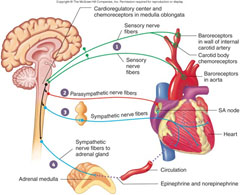
Nerve system which drives heartbeat timing. Going down a level, heart health can depend on the health of the cells in the heart which depend in turn on the health of the cellular components such as the cell mitochondria and integrity of the internal cell skeletal and transport systems. And in all of these cases, a complexity of molecular mechanisms is at work.
Image source A limited representation of systems affecting the heart
Engineers who design extremely complex systems like a nuclear power plant or jet airplanes have developed some key systems theory concepts and principles that can be carried over directly into biology. A few of these are:
- For any subsystem, there are certain measurable operating parameters which must be kept within well-defined ranges for continuing functioning of that subsystem (and the system as a whole) to be possible For example, in
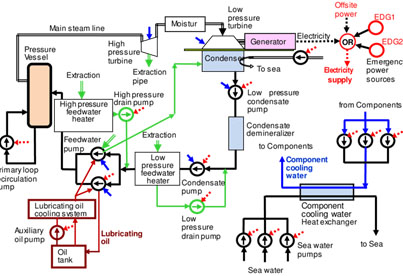 a nuclear power plant, in the low pressure feedwater subsystem the water pressure, temperature, salinity, acidity, and flow rate must be kept within well-defined numerical ranges. If this is not done the pipes could crack or corrode, or the nuclear reactor could run too hot or too cold, for example. So, gauges measure these parameters at several critical points, and feed the measurements into a computer. If a parameter or several go out of acceptable range the computer takes steps to correct the situation if it can. Like increasing cold water intake if the water temperature is too hot. If those steps don’t work the computer will notify the operators and if necessary shut the reactor down. If this system does not work well? We know what happened at Chernobyl. Image source
a nuclear power plant, in the low pressure feedwater subsystem the water pressure, temperature, salinity, acidity, and flow rate must be kept within well-defined numerical ranges. If this is not done the pipes could crack or corrode, or the nuclear reactor could run too hot or too cold, for example. So, gauges measure these parameters at several critical points, and feed the measurements into a computer. If a parameter or several go out of acceptable range the computer takes steps to correct the situation if it can. Like increasing cold water intake if the water temperature is too hot. If those steps don’t work the computer will notify the operators and if necessary shut the reactor down. If this system does not work well? We know what happened at Chernobyl. Image source
In the human body there are completely comparable situations. Consider blood flow into the heart, for example. Numerous parameters like blood pressure, temperature, electrolyte balance, red and white blood cell count, and heart beat rates must be kept within normal operating parameter range.
So the body continuously measures these and countless other parameters as well and is constantly making adjustments to keep them all consistently within normal operating range. In
biology this process is known as seeking homeostasis. Consistent fine tuning is involved.
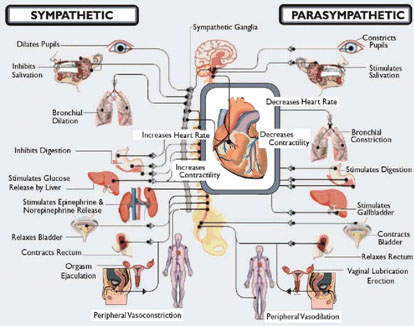
E.g. The Vagus Nerve in the parasympatic nervous system accepts inputs from the major body systems and actually computes the best time for every single next heart beat. If this is done well there is considerable heart rate variability (HRV) in the timing of heart beats. High HRV is an indicator of body systems resilience and general health, and low mortality. If such systems coordination is not done well, HRV is low, and this is a predictor of disease and higher mortality. Image source The sympathetic and parasympathetic nervious systems and the heart
- Operations of numerous subsystems must be coordinated, again to keep all critical parameters within normal operating ranges (i.e. in a biological organism, maintain homeostasis). In the case of a typical nuclear reactor, there are radiation monitoring systems, electrical management systems, fission management systems, steam flow, high-pressure feedwater, turbine management, and wastewater man
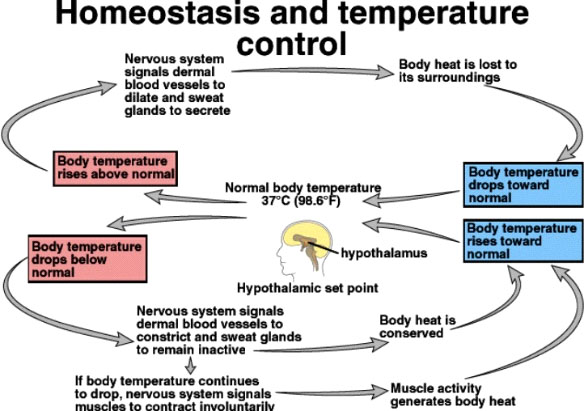 agement systems, to mention a few. All are critical. And in the human body we have the circulatory, nervous, endocrine, pulmonary, digestive, and cardiovascular systems, and all the major organ systems. All must be managed together to keep all critical operating parameters within range (maintain homeostasis).
agement systems, to mention a few. All are critical. And in the human body we have the circulatory, nervous, endocrine, pulmonary, digestive, and cardiovascular systems, and all the major organ systems. All must be managed together to keep all critical operating parameters within range (maintain homeostasis).
Image source One of a great many of body control systems
The body’s capability to do that is incredible although we take it for normal. As an example, consider what just happened while I took a 25 minute vigorous walk as an exercise break from this writing: my heart started beating faster to provide more oxygen to my musculature tissues my vascular system dilated a little to accommodate the increased blood flow, my lungs started breathing deeper and more frequently, and my airways systems dilated a little to accommodate that. I started to sweat a little as my body got hotter due to increased metabolism, and my mitochondria responded to a signal to produce more ATP for energy. My hypothalmus gets involved in assuring temperature homeostasis as in the diagram. And numerous secondary loops also got activated, like ones connected with the metabolic cycle, mitochondrial functioning, and neuromuscular control. All of that activation of numerous feedback loops happened without me thinking about it at all. And as I write this my heart is slowing to normal and other systems are going back to normal too,
- The autonomic control systems in the body, unlike those in a nuclear power plant, exhibit an amazing additional property, known as Hormesis. That is, in response to any stress that does not exceed a certain limit, the body or body subsystem feedback loops re-tune themselves so that the body subsystem is stronger and better off than before the stress was applied. That, for example, is why the stress of non-excessive exercise is good for me. And why the hypoxic stress of reducing arm blood circulation with a cuff can lead to better surgical outcomes. “Although radiation has been thought to be harmful no matter how low the dose exposure, accumulating evidence suggests that hormesis is a real phenomenon and that bioprotective functions including antioxidant capacity, DNA repair, apoptosis, and immune responses are induced by low doses of radiation (Sakai, 2006)(Wikipedia); . See this list of blog writings by Vince relating to Hormesis and its properties.
- Underlying conditions related to homeostatic equilibrium can be very different, depending on biological age. While quick-acting feedback loops in the body work to maintain homeostasis at all times, the balance of elements and gene activation necessary to do this will vary widely depending on age and health. My body and the bodies of my 4 year-old and 18 year-old grandchildren are in homeostasis, yet the balances in each of us are very different. Those of us over 80, for example, will have experienced severe decline in many key hormones as well as in NAD+, sirtuins, AMPK, and many other key proteins. And up-regulation of many other proteins such as mTOR and IGF-1. “It is well documented that the effectiveness of the immune system peaks at puberty and gradually declines thereafter with advance in age. For example, as one grows older, antibodies lose their effectiveness, and fewer new diseases can be combated effectively by the body, which causes cellular stress and eventual death.. Indeed, dysregulated immune response has been linked to cardiovascular disease, inflammation, Alzheimer’s disease (AD), and cancer(ref)” Our aging bodies may be in states of chronic inflammation and aberrant redox potential, and our thymus glands have all but disappeared. Our DNA will have different balances of mutations, aneuploidy, methylation, and alternative splicing. Signs of Aging are likely to be everywhere you look, in all organs and manifest on all systems levels as well as in cells. And many of the feedback loops work a lot more slowly than the fast-acting ones I mentioned connected with exercise.
- Aging and YOUNGING requires multiple information feedback loops on multiple systems levels interacting with each other to come into new states of equilibrium, and this can take a lot of time. Events on the molecular biology level, the level of cell organelles, the tissue-type level, the organ level and the systems level all impact each other, and these all coming into equilibrium can require complex time-consuming interactions. This is why YOUNGING is necessarily a slow process that takes a lot of time. As a hypothetical example, consider an older man with insufficient level of intracellular NAD+. As a consequence he is not generating enough SIRT1 to do an adequate job of DNA repair and there is insufficient SIRT1 to produce mitochondrial proteins required for mitochondrial health. As a result, mitochondria tend to leak reactive oxygen species (ROS), which has driven his body into an oxidative redox state. And improperly repaired DNA is leading to his having dysfunctional and improperly folded proteins. There are many bad consequences such as more DNA damage, a highly inflammatory general systemic state, diminished production of heat shock proteins which can properly refold proteins, and an even greater demand for the limited supply of SIRT1. A downwards spiral is in place. Say that person starts to take a supplement to increase the NAD+ level like nicotinamide riboside and to take resveratrol pills to increase SIRT1. Slowly, the events in this chain of consequences may start to reverse – but it might require a long time on the supplements before the systemic inflammation starts to subside, if at all. Basic changes associated with Aging take years to happen. And it appears to us that they will likewise require years to be reversed in the course of YOUNGING.
We speculate now, and will flesh out details in the future, that systematic, healthful interventions at multiple levels at the same time is likely to trigger a faster process of YOUNGING.
There is much more to be said. And we endeavor to say it. We suggest that our readers proceed next directly to our first substantive blog entry YOUNGING 1.0 – THE EMERGING AGING REVERSAL STRATEGY.


Pingback: YOUNGING1.0 – THE EMERGING AGING REVERSAL STRATEGY - AGINGSCIENCES™ - Anti-Aging Firewalls™AGINGSCIENCES™ – Anti-Aging Firewalls™
Pingback: YGC MORE ON YOUNGING1.0 – THE EMERGING AGING REVERSAL STRATEGY - AGINGSCIENCES™ - Anti-Aging Firewalls™AGINGSCIENCES™ – Anti-Aging Firewalls™
Pingback: YGD YOUNGING1.0 PART 4: UNDERLYING MECHANISMS OF YOUNGING 1.0. HSC STEM CELL DIFFERENTIATION - AGINGSCIENCES™ - Anti-Aging Firewalls™AGINGSCIENCES™ – Anti-Aging Firewalls™
Pingback: YGE YOUNGING 1.0 PART 5: PRACTICAL INITIATION OF YOUNGING 1.0 VIA HYPOXIC INTERVENTIONS - AGINGSCIENCES™ - Anti-Aging Firewalls™AGINGSCIENCES™ – Anti-Aging Firewalls™
Pingback: The International Longevity Summit Speakers: Part 5 - Longevity LIVE